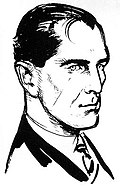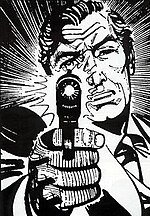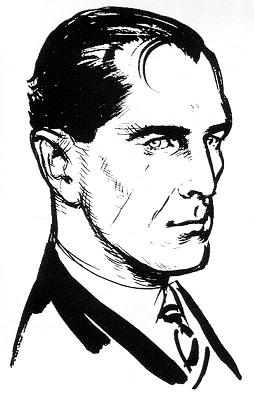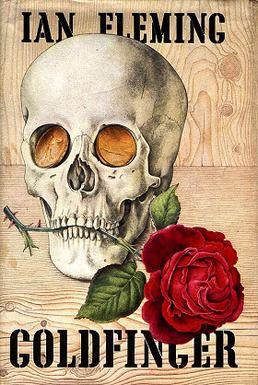Publication history
Daily Express strips
| James Bond | |
|---|---|
| Author(s) | Anthony Hern (1958) Henry Gammidge (1958–1966) Peter O'Donnell (1960) Jim Lawrence (1966–1984) |
| Illustrator(s) | John McLusky (1958–1966, 1981–1983) Yaroslav Horak (1966–1979, 1983–1984) Harry North (1981) |
| Current status/schedule | Concluded daily and Sunday strip; reruns |
| Launch date | 7 July 1958 |
| End date | 1984 |
| Syndicate(s) | Daily Express (reruns) Andrews McMeel Syndication |
| Publisher(s) | Titan Books |
| Genre(s) | Adventure |
In 1957, the Daily Express , a newspaper owned by Lord Beaverbrook, approached Ian Fleming about adapting his James Bond stories as comic strips. Fleming was then reluctant, because he felt the comic strips would lack the quality of his writing, potentially hurting his spy novel series while he was still writing. Fleming wrote:
The Express are desperately anxious to turn James Bond into a strip cartoon. I have grave doubts about the desirability of this ... Unless the standard of these books is maintained they will lose their point, and, I think, there I am in grave danger that inflation will spoil not only the readership, but also become something of a death-watch beetle inside the author. A tendency to write still further down might result. The author would see this happening, and disgust with the operation might creep in.
Art by John McLusky


Regardless, Fleming later agreed, and to aid the Daily Express in illustrating James Bond, Fleming commissioned an artist to sketch whom he believed James Bond to look like. The assigned illustrator, John McLusky, however, felt that Fleming's 007 appeared too "outdated" and "pre-war", and thus changed James Bond to a more rugged and masculine appearance.[ citation needed ]
The first strip, Casino Royale , was published in 1958. The story was adapted by Anthony Hern, who previously had serialised Diamonds Are Forever and From Russia with Love for the Daily Express. The majority of the early comic strips were adapted by Henry Gammidge (other than the Dr. No adaptation, 1960, by Peter O'Donnell, years before he launched his strip Modesty Blaise ). McLusky later would illustrate twelve more James Bond comic strips with partner Gammidge until 1966.[ citation needed ]

In 1962 the Daily Express abruptly cancelled their agreement with Ian Fleming when Lord Beaverbrook and Fleming disputed the rights to the James Bond short story "The Living Daylights". Fleming had sold the rights to the Sunday Times , a rival newspaper—upsetting Beaverbrook into terminating his business relationship with Fleming. The dispute abruptly ended the comic strip adaptation of Thunderball. Additional panels were added later for its syndication to other newspapers, and to expand and conclude the story. Beaverbrook and Fleming later settled their differences, and the comic strip serial would continue in 1964 with On Her Majesty's Secret Service .
| Title | Writer | Date | Serial no. |
|---|---|---|---|
| Casino Royale | Anthony Hern | 7 July 1958 – 13 December 1958 | 1–138 |
| Live and Let Die | Henry Gammidge | 15 December 1958 – 28 March 1959 | 139–225 |
| Moonraker | Henry Gammidge | 30 March 1959 – 8 August 1959 | 226–339 |
| Diamonds Are Forever | Henry Gammidge | 10 August 1959 – 30 January 1960 | 340–487 |
| From Russia, with Love | Henry Gammidge | 1 February 1960 – 21 May 1960 | 488–583 |
| Dr. No | Peter O'Donnell | 23 May 1960 – 1 October 1960 | 584–697 |
| Goldfinger | Henry Gammidge | 3 October 1960 – 1 April 1961 | 698–849 |
| Risico | Henry Gammidge | 3 April 1961 – 24 June 1961 | 850–921 |
| From a View to a Kill | Henry Gammidge | 26 June 1961 – 9 September 1961 | 922–987 |
| For Your Eyes Only | Henry Gammidge | 11 September 1961 – 9 December 1961 | 988–1065 |
| Thunderball | Henry Gammidge | 11 December 1961 – 10 February 1962 | 1066–1128 |
| On Her Majesty's Secret Service | Henry Gammidge | 29 June 1964 – 15 May 1965 | 1–274 |
| You Only Live Twice | Henry Gammidge | 17 May 1965 – 8 January 1966 | 275–475 |
Art by Yaroslav Horak

In 1966 Yaroslav Horak replaced John McLusky as the artist for the Daily Express comic strip series and adapted six more Ian Fleming James Bond novels and short stories as well as Kingsley Amis' Colonel Sun with partner Jim Lawrence. The Living Daylights was also republished in the Daily Express after first appearing in the first edition of the Sunday Times magazine on 4 February 1962 and in the American magazine Argosy in June of the same year under the title Berlin Escape.
With the success of The Man with the Golden Gun Horak and Lawrence subsequently went on to write and illustrate twenty original James Bond comic strips for the Daily Express after being granted permission by Ian Fleming's Trust.
| Title | Writer | Date | Serial no. |
|---|---|---|---|
| The Man with the Golden Gun | Jim Lawrence | 10 January 1966 – 9 September 1966 | 1–209 |
| The Living Daylights | Jim Lawrence | 12 September 1966 – 12 November 1966 | 210–263 |
| Octopussy | Jim Lawrence | 14 November 1966 – 27 May 1967 | 264–428 |
| The Hildebrand Rarity | Jim Lawrence | 29 May 1967 – 16 December 1967 | 429–602 |
| The Spy Who Loved Me | Jim Lawrence | 18 December 1967 – 3 October 1968 | 603–815 |
| The Harpies | Jim Lawrence | 10 October 1968 – 23 June 1969 | 816–1037 |
| River of Death | Jim Lawrence | 24 June 1969 – 29 November 1969 | 1038–1174 |
| Colonel Sun | Jim Lawrence | 1 December 1969 – 28 August 1970 | 1175–1393 |
| The Golden Ghost | Jim Lawrence | 21 August 1970 – 16 January 1971 | 1394–1519 |
| Fear Face | Jim Lawrence | 18 January 1971 – 20 April 1971 | 1520–1596 |
| Double Jeopardy | Jim Lawrence | 21 April 1971 – 28 August 1971 | 1597–1708 |
| Starfire | Jim Lawrence | 30 August 1971 – 24 December 1971 | 1709–1809 |
| Trouble Spot | Jim Lawrence | 28 December 1971 – 10 June 1972 | 1810–1951 |
| Isle of Condors | Jim Lawrence | 12 June 1972 – 21 October 1972 | 1952–2065 |
| The League of Vampires | Jim Lawrence | 25 October 1972 – 28 February 1973 | 2066–2172 |
| Die with My Boots On | Jim Lawrence | 1 March 1973 – 18 June 1973 | 2173–2256 |
| The Girl Machine | Jim Lawrence | 19 June 1973 – 3 December 1973 | 2257–2407 |
| Beware of Butterflies | Jim Lawrence | 4 December 1973 – 11 May 1974 | 2408–2541 |
| The Nevsky Nude | Jim Lawrence | 13 May 1974 – 21 September 1974 | 2542–2655 |
| The Phoenix Project | Jim Lawrence | 23 September 1974 – 18 February 1975 | 2656–2780 |
| The Black Ruby Caper | Jim Lawrence | 19 February 1975 – 15 July 1975 | 2781–2897 |
| Till Death Do Us Apart | Jim Lawrence | 7 July 1975 – 14 October 1975 | 2898–2983 |
| The Torch-Time Affair | Jim Lawrence | 15 October 1975 – 15 January 1976 | 2984–3060 |
| Hot-Shot | Jim Lawrence | 16 January 1976 – 1 June 1976 | 3061–3178 |
| Nightbird | Jim Lawrence | 2 June 1976 – 4 November 1976 | 3179–3312 |
| Ape of Diamonds | Jim Lawrence | 5 November 1976 – 22 January 1977 | 3313–3437 |
Other James Bond comic strips
In 1977 the Daily Express discontinued their series of Bond comic strips, although Horak and Lawrence went on to write and illustrate several other James Bond adventures for syndication abroad in Europe, for the Sunday Express (the Sunday edition of the Daily Express), and the Daily Star . Additionally, John McLusky returned to team up with Jim Lawrence for five comic strips. One strip, Doomcrack, featured artwork by Harry North, who at the time worked for MAD Magazine on its film parodies.
The 1983 strip Polestar was abruptly terminated by the Daily Star midway through its run and was not completed, although the complete story did appear in non-UK newspapers and was followed by several more complete serials before the James Bond comic strip officially came to an end.
| Title | Artist | Writer | Date | Serial no. |
|---|---|---|---|---|
| When the Wizard Awakes | Yaroslav Horak | Jim Lawrence | 30 January 1977 – 22 May 1977 | 1–54 |
| Sea Dragon | Yaroslav Horak | Jim Lawrence | 1977 | 55–192 |
| Death Wing | Yaroslav Horak | Jim Lawrence | 1977–1978 | 193–354 |
| The Xanadu Connection | Yaroslav Horak | Jim Lawrence | 1978 | 355–468 |
| Shark Bait | Yaroslav Horak | Jim Lawrence | 1978–1979 | 469–636 |
| Doomcrack | Harry North | Jim Lawrence | 2 February 1981 – 19 August 1981 | 1–174 |
| The Paradise Plot | John McLusky | Jim Lawrence | 20 August 1981 – 4 June 1982 | 175–378 |
| Deathmask | John McLusky | Jim Lawrence | 7 June 1982 – 2 February 1983 | 379–552 |
| Flittermouse | John McLusky | Jim Lawrence | 9 February 1983 – 20 May 1983 | 553–624 |
| Polestar | John McLusky | Jim Lawrence | 23 May 1983 – 15 July 1983 | 625–719 |
| The Scent of Danger | John McLusky | Jim Lawrence | 1983 | 720–821 |
| Snake Goddess | Yaroslav Horak | Jim Lawrence | 1983–1984 | 822–893 |
| Double Eagle | Yaroslav Horak | Jim Lawrence | 1984 | 894–965 |










